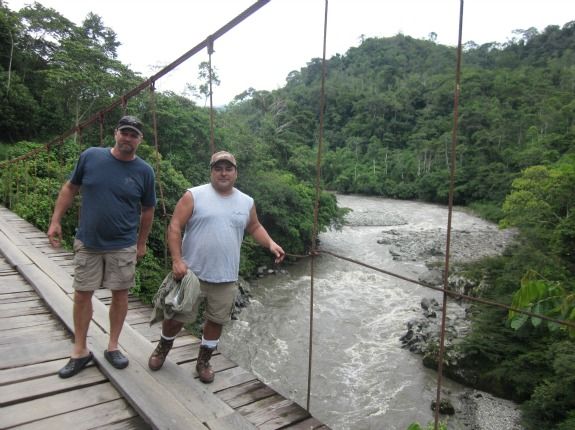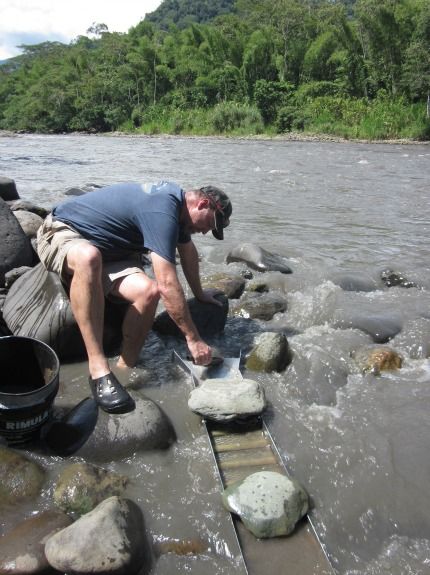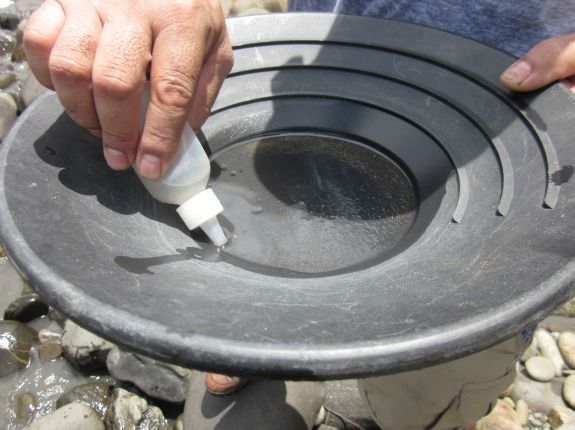Hunting for Gold in the Amazonian Jungle
The author joins two American fortune-seekers on a gold-panning outing at the confluence of the Negro and Paute rivers
/https://tf-cmsv2-smithsonianmag-media.s3.amazonaws.com/filer/20130228083126GoldInHand2.jpg)
People visit Ecuador for many reasons. Some come to see birds. Many come to surf. Others come to climb mountains. A few want to see its dynamic landscape by bicycle. But when the price of gold hit $1,800 per ounce several months ago, Texans Paul Salazar and Curt McGary came looking to make a fortune. I met the pair in Santiago de Mendez, a jungle town downriver from Cuenca, in air as thick and muggy as I always imagined the Amazon would be. Salazar, who had panned for gold and other heavy metals in Alaska and Arizona, had a good feeling about the local drainage system. He and McGary had researched ahead, using the guidance of an online gold mining guru named Stan Grist, who provides information and assistance to those seeking an escape from the rat race of more common lifestyles and, hopefully, a heavy metal fortune pulled from the earth. Grist advised Salazar via e-mail that the rivers of Ecuador could be, if not technically a mother lode, a rich and promising location for prospectors hunting gold.
“I’ve got a really good feeling about that place,” Salazar said to McGary as we all drank coffee in a cheap restaurant near our hotel. McGary had never panned for gold before but had come along in hopes of making some real money—and prospects looked good. The morning prior the pair had briefly visited the shore of the Rio Paute. Salazar panned just one scoop of dirt and came away with the largest flake he had ever seen, now contained in a vial. I would have photographed the trophy except that it was almost too small to see.
I joined the men for their second day on the river. We hailed a taxi in the plaza, and Salazar and McGary, holding a Google maps printout, showed the driver where they wished to go. They pointed to the confluence of the Negro and Paute rivers, never mentioning that they were after gold. The driver nodded in recognition of the location and turned the ignition as the Texans threw their gear—including buckets, pans and a sluice tray—into the rear of the pickup.
We drove several miles southeast through tall jungle trees wrapped with vines and thick foliage. It is said that one can walk for a mile through the Amazon and never see the same species of tree twice. I’m no botanist and they all looked about the same to me—tall and graceful beauties with glossy leaves and buttressed trunks. “I can’t believe we’re in the Amazon rainforest,” I said aloud. I asked the driver in Spanish if jaguars lived here. “Yes,” he said. And pumas? “Yes.” And anacondas? “Yes.”
It was official: This was the jungle.
We abruptly exited the dense woods on a bridge that crossed the roiling brown river 100 feet below. The banks were steep and strewn with huge boulders. Among these rocks was the dirt that might bear a fortune.
“Nobody’s mined for gold here before,” Salazar said, excitement heating up in his voice as we drew closer to the river. “This is unexplored country.”
Our driver jutted his thumb at a pair of local men hiking along the road with buckets. “Mineros de oro,” he said.

Salazar’s glimmering image of a virgin river of untouched gold suddenly sparkled a shade less—though the fact that locals hunted for gold here offered its own promise. We confirmed a 4:30 pickup with the cab driver, who pointed us down a slippery trail into the jungle, a kilometer to the river via a farmer’s property. “He’s a very nice man,” the driver assured us. We trudged into the forest, past cacao and banana trees and, finally, to the rustic homestead, a complex of decrepit shacks. Four frantic, emaciated dogs howled and ran circles around us as we called out our greetings for five minutes. No one answered, and we finally mustered the gall to march through the private residence, past a sugarcane grinder and hanging bunches of green bananas, and onward, through the papaya trees and sugarcane, toward the river.
“We’ll have to pay him a gold tax when we come back,” I said.
Gold mining is backbreaking work. Panning is the easiest, if slowest means of finding gold, though sitting on a rock in the sun for 30 minutes swirling a saucer of mucky water is surprisingly laborious. After an hour, we had found several minuscule flakes. Salazar pointed them out in his tray and, later, in my own. Gold can be identified by the way it moves through the swirling water; while other materials lift and move about easily as the pan is shaken, flakes of gold—one of the heaviest elements—will stay put. I had a pair of flakes isolated near the rim of my pan, but I was having difficulty separating the silt from the gold. For 20 more minutes I worked on trying to isolate the flecks. They were almost microscopic, and I wondered at the seeming futility of this work.
I said to McGary, “I’ve heard that the ones who got the richest in the California gold rush were those who owned convenience stores near the camps. You guys should start a brewpub here when the gold rush starts.”
At about 2 p.m. Salazar found six flakes in his pan and, believing he had found a patch of rich soil, got out the trowels, buckets and sluice tray. He and McGary unfolded the contraption and laid it in the shallows, where just enough current ran through to carry gravel and silt fed into it at the top. A sluice tray effectively accomplishes the same task as panning, but faster and with less effort. Digging out the soil from between the boulders, however, is the hard part. The men took turns on their bellies, arms three feet down, using a trowel to scoop out mucky gravel that may not have seen the light of day in decades. Scoop by scoop, the material was fed through a colander, then carried in buckets to the sluice tray and fed, a handful at a time, into the six-foot-long metal chute. Stan Grist had advised the Texans that the alluvium of Ecuador could contain as much as a half ounce of gold per cubic yard. It seemed like it would take all day to process so much earth—but Salazar insisted that productive gold streams can reward the miner with up to $50 per hour.

“Man, I can’t believe we’re here—in the jungle!” Salazar said, sweat on his brow as he leaned back in the tropical sun. “Don’t get me wrong. I want to make money. Just a half ounce of gold and our trip is paid for. But I’m really here for the adventure of it all.”
I grew queasy in the early afternoon—a stomach illness that would persist for the next 48 hours—and I lay in the shade. “It’s because you don’t eat enough meat,” Salazar said, only half joking. “That has nothing to do with it,” I mumbled. In fact, I had been invited into a home the day before and fed guinea pig and pork—the first pig I’d knowingly eaten in a decade. I ate the meat to be polite and was perhaps paying for it now.
McGary came back from the sluice tray and picked up a pan to work a smaller scoop of dirt.
“Not exactly fast money, is it?” I said.
He laughed and shrugged. Salazar was now down the shore, taking his turn feeding earth into the sluice tray, confident there was money to be extracted from this ground. His energy and enthusiasm were remarkable, given the heavy labor inherent to gold mining, the small odds of making money and, on top of it all, the hot muggy air.
At 4, we packed it up and trudged back up to the road and waited by the suspension bridge for our ride. The Texans ached all over after six hours of labor. I felt sick. The cab arrived. In town, I went for bananas and bubbly water at the corner store, and from a passing pickup truck a bucket of water went over my head and shoulders, followed by laughter. It was the last day of Carnaval, the holiday often associated with Rio de Janeiro and which manifests in Ecuador as three days of, mostly, people sitting on the curb in their underwear and spraying each other with hoses or otherwise drenching each other.
I returned to the hotel, dripping wet. McGary, I discovered, had been hit in the back with a raw egg—another popular form of ammo on Carnaval—and had just taken his second shower of the afternoon. I sat with the men at the restaurant across the street where they ate $2 rice and fried meat—the culinary specialty of the region. Salazar was having a friendly feud with our teenage waitress, who promised to hit him with an egg later. “Tengo un huevo por usted!” she said with some sass. I thought it funny that she used the formal, respectful form of “you”—usted—while threatening to hit him with a raw egg.
Salazar still brimmed with excitement.
“To find six flakes in one pan—now that’s rich dirt!” he said. “I have a good feeling about this place.”
I rolled onward the next morning, saying goodbye to the Texans as they assembled their mining gear in the lobby. I pedaled north through the Amazon, aiming for Puyo in several days, from which town I would ride uphill via the Pastaza River canyon to the popular tourist town of Baños. Five days after I left them I received an e-mail from Curt. “Didn’t find a lot of gold but probably could with the right machinery,” he said. McGary said they were now headed for the coast, where their wives were to meet them for some rest and relaxation. But Salazar had told me he planned to walk the beaches with a metal detector, still envisioning gold—even if the flecks in the sand were almost too small to see.

Planning Your Next Trip?
Explore great travel deals
Smithsonian magazine participates in affiliate link advertising programs. If you purchase an item through these links, we receive a commission.
/https://tf-cmsv2-smithsonianmag-media.s3.amazonaws.com/accounts/headshot/Off-Road-alastair-bland-240.jpg)
/https://tf-cmsv2-smithsonianmag-media.s3.amazonaws.com/accounts/headshot/Off-Road-alastair-bland-240.jpg)